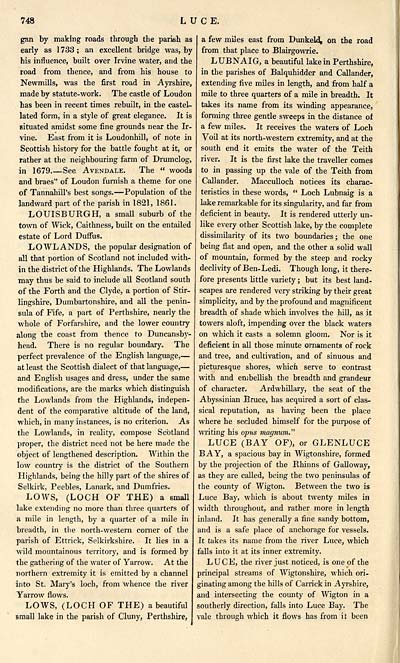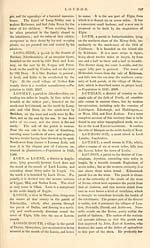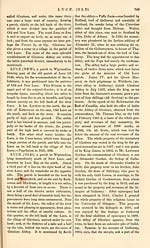Gazetteer of Scotland > Volume 2
(264) Page 748
Download files
Complete book:
Individual page:
Thumbnail gallery: Grid view | List view

748
LUCE.
gan by making roads through the parish as
early as 1733; an excellent bridge was, by
his influence, built over Irvine water, and the
road from thence, and from his house to
Newmills, was the first road in Ayrshire,
made by statute- work. The castle of Loudon
has been in recent times rebuilt, in the castel-
lated form, in a style of great elegance. It is
situated amidst some fine grounds near the Ir-
vine. East from it is Loudonhill, of note in
Scottish history for the battle fought at it, or
rather at the neighbouring farm of Drumclog,
in 1679 See Avendale. The " woods
and braes" of Loudon furnish a theme for one
of Tannahill's best songs. — Population of the
landward part of the parish in 1821, 1861.
LOUISBURGH, a small suburb of the
town of Wick, Caithness, built on the entailed
estate of Lord Duffus.
LOWLANDS, the popular designation of
all that portion of Scotland not included with-
in the district of the Highlands. The Lowlands
may thus be said to include all Scotland south
of the Forth and the Clyde, a portion of Stir-
lingshire, Dumbartonshire, and all the penin-
sula of Fife, a part of Perthshire, nearly the
whole of Forfarshire, and the lower country
along the coast from thence to Duncansb}*-
head. There is no regular boundary. The
perfect prevalence of the English language, —
at least the Scottish dialect of that language, —
and English usages and dress, under the same
modifications, are the marks which distinguish
the Lowlands from the Highlands, indepen-
dent of the comparative altitude of the land,
which, in many instances, is no criterion. As
the Lowlands, in reality, compose Scotland
proper, the district need not be here made the
object of lengthened description. Within the
low country is the district of the Southern
Highlands, being the hilly part of the shires of
Selkirk. Peebles, Lanark, and Dumfries.
LOWS, (LOCH OF THE) a small
lake extending no more than three quarters of
a mile in length, by a quarter of a mile in
breadth, in the north-western comer of the
parish of Ettrick, Selkirkshire. It lies in a
wild mountainous territory, and is formed by
the gathering of the water of Yarrow. At the
northern extremity it is emitted by a channel
into St. Mary's loch, from whence the river
Yarrow flows.
LOWS, (LOCH OF THE) a beautiful
small lake in the parish of Cluny, Perthshire,
a few miles east from Dunkeld, on the road
from that place to Blairgowrie.
LUBNAIG, a beautiful lake in Perthshire,
in the parishes of Balquhidder and Callander,
extending five miles in length, and from half a
mile to three quarters of a mile in breadth. It
takes its name from its winding appearance,
forming three gentle sweeps in the distance of
a few miles. It receives the waters of Loch
Voil at its north-western extremity, and at the
south end it emits the water of the Teith
river. It is the first lake the traveller comes
to in passing up the vale of the Teith from
Callander. Macculloch notices its charac-
teristics in these words, " Loch Lubnaig is a
lake remarkable for its singularity, and far from
deficient in beauty. It is rendered utterly un-
like every other Scottish lake, by the complete
dissimilarity of its two boundaries; the one
being flat and open, and the other a solid wall
of mountain, formed by the steep and rocky
declivity of Ben-Ledi. Though long, it there-
fore presents little variety ; but its best land-
scapes are rendered very striking by their great
simplicity, and by the profound and magnificent
breadth of shade which involves the hill, as it
towers aloft, impending over the black waters
on which it casts a solemn gloom. Nor is it
deficient in all those minute ornaments of rock
and tree, and cultivation, and of sinuous and
picturesque shores, which serve to contrast
with and embellish the breadth and grandeur
of character. Ardwhillary, the seat of the
Abyssinian Bruce, has acquired a sort of clas-
sical reputation, as having been the place
where he secluded himself for the purpose of
writing his opus magnum."
LUCE (BAY OF), or GLENLUCE
BAY, a spacious bay in Wigtonshire, formed
by the projection of the Rhinns of Galloway,
as they are called, being the two peninsulas of
the county of Wigton. Between the two is
Luce Bay, which is about twenty miles in
width throughout, and rather more in length
inland. It has generally a fine sandy bottom,
and is a safe place of anchorage for vessels.
It takes its name from the river Luce, which
falls into it at its inner extremity.
LUCE, the river just noticed, is one of the
principal streams of Wigtonshire, which ori-
ginating among the hills of Carrick in Ayrshire,
and intersecting the county of Wigton in a
southerly direction, falls into Luce Bay. The
vale through which it flows has from it been
LUCE.
gan by making roads through the parish as
early as 1733; an excellent bridge was, by
his influence, built over Irvine water, and the
road from thence, and from his house to
Newmills, was the first road in Ayrshire,
made by statute- work. The castle of Loudon
has been in recent times rebuilt, in the castel-
lated form, in a style of great elegance. It is
situated amidst some fine grounds near the Ir-
vine. East from it is Loudonhill, of note in
Scottish history for the battle fought at it, or
rather at the neighbouring farm of Drumclog,
in 1679 See Avendale. The " woods
and braes" of Loudon furnish a theme for one
of Tannahill's best songs. — Population of the
landward part of the parish in 1821, 1861.
LOUISBURGH, a small suburb of the
town of Wick, Caithness, built on the entailed
estate of Lord Duffus.
LOWLANDS, the popular designation of
all that portion of Scotland not included with-
in the district of the Highlands. The Lowlands
may thus be said to include all Scotland south
of the Forth and the Clyde, a portion of Stir-
lingshire, Dumbartonshire, and all the penin-
sula of Fife, a part of Perthshire, nearly the
whole of Forfarshire, and the lower country
along the coast from thence to Duncansb}*-
head. There is no regular boundary. The
perfect prevalence of the English language, —
at least the Scottish dialect of that language, —
and English usages and dress, under the same
modifications, are the marks which distinguish
the Lowlands from the Highlands, indepen-
dent of the comparative altitude of the land,
which, in many instances, is no criterion. As
the Lowlands, in reality, compose Scotland
proper, the district need not be here made the
object of lengthened description. Within the
low country is the district of the Southern
Highlands, being the hilly part of the shires of
Selkirk. Peebles, Lanark, and Dumfries.
LOWS, (LOCH OF THE) a small
lake extending no more than three quarters of
a mile in length, by a quarter of a mile in
breadth, in the north-western comer of the
parish of Ettrick, Selkirkshire. It lies in a
wild mountainous territory, and is formed by
the gathering of the water of Yarrow. At the
northern extremity it is emitted by a channel
into St. Mary's loch, from whence the river
Yarrow flows.
LOWS, (LOCH OF THE) a beautiful
small lake in the parish of Cluny, Perthshire,
a few miles east from Dunkeld, on the road
from that place to Blairgowrie.
LUBNAIG, a beautiful lake in Perthshire,
in the parishes of Balquhidder and Callander,
extending five miles in length, and from half a
mile to three quarters of a mile in breadth. It
takes its name from its winding appearance,
forming three gentle sweeps in the distance of
a few miles. It receives the waters of Loch
Voil at its north-western extremity, and at the
south end it emits the water of the Teith
river. It is the first lake the traveller comes
to in passing up the vale of the Teith from
Callander. Macculloch notices its charac-
teristics in these words, " Loch Lubnaig is a
lake remarkable for its singularity, and far from
deficient in beauty. It is rendered utterly un-
like every other Scottish lake, by the complete
dissimilarity of its two boundaries; the one
being flat and open, and the other a solid wall
of mountain, formed by the steep and rocky
declivity of Ben-Ledi. Though long, it there-
fore presents little variety ; but its best land-
scapes are rendered very striking by their great
simplicity, and by the profound and magnificent
breadth of shade which involves the hill, as it
towers aloft, impending over the black waters
on which it casts a solemn gloom. Nor is it
deficient in all those minute ornaments of rock
and tree, and cultivation, and of sinuous and
picturesque shores, which serve to contrast
with and embellish the breadth and grandeur
of character. Ardwhillary, the seat of the
Abyssinian Bruce, has acquired a sort of clas-
sical reputation, as having been the place
where he secluded himself for the purpose of
writing his opus magnum."
LUCE (BAY OF), or GLENLUCE
BAY, a spacious bay in Wigtonshire, formed
by the projection of the Rhinns of Galloway,
as they are called, being the two peninsulas of
the county of Wigton. Between the two is
Luce Bay, which is about twenty miles in
width throughout, and rather more in length
inland. It has generally a fine sandy bottom,
and is a safe place of anchorage for vessels.
It takes its name from the river Luce, which
falls into it at its inner extremity.
LUCE, the river just noticed, is one of the
principal streams of Wigtonshire, which ori-
ginating among the hills of Carrick in Ayrshire,
and intersecting the county of Wigton in a
southerly direction, falls into Luce Bay. The
vale through which it flows has from it been
Set display mode to: Large image | Transcription
Images and transcriptions on this page, including medium image downloads, may be used under the Creative Commons Attribution 4.0 International Licence unless otherwise stated. ![]()
| Gazetteers of Scotland, 1803-1901 > Gazetteer of Scotland > Volume 2 > (264) Page 748 |
|---|
| Permanent URL | https://digital.nls.uk/97433990 |
|---|
| Description | Volume II: Glenbanchor to Zetland. |
|---|---|
| Attribution and copyright: |
|
| Description | By Robert Chambers and William Chambers. Glasgow: Blackie & Son, 1838. 2 volumes. |
|---|---|
| Shelfmark | NF.1461.g.7 |
| Additional NLS resources: | |

